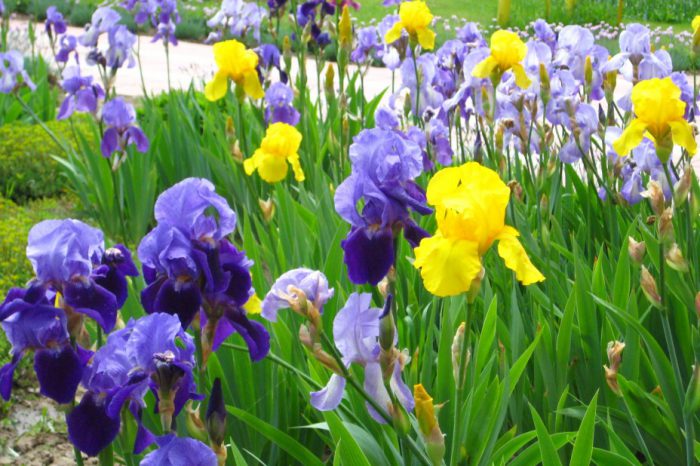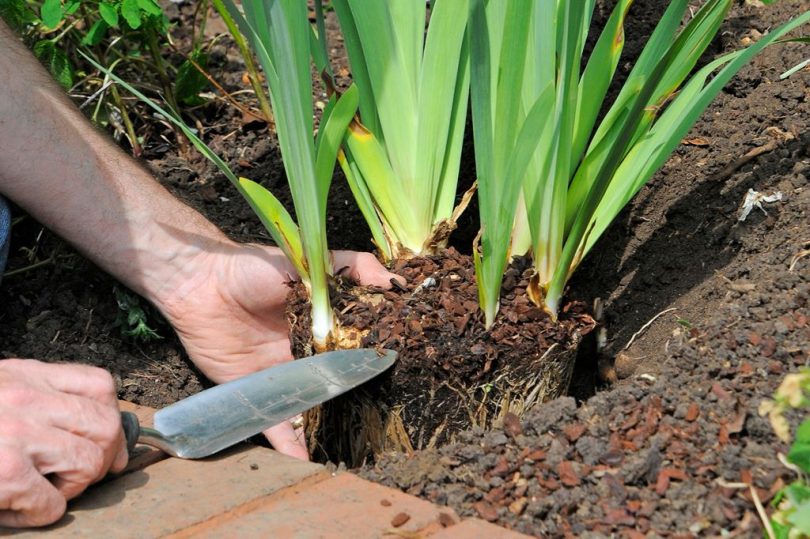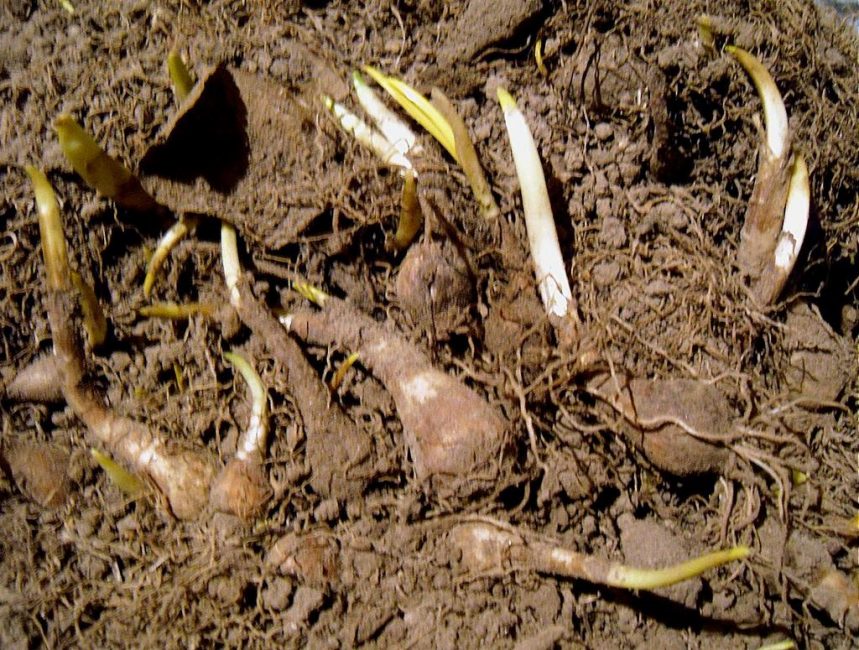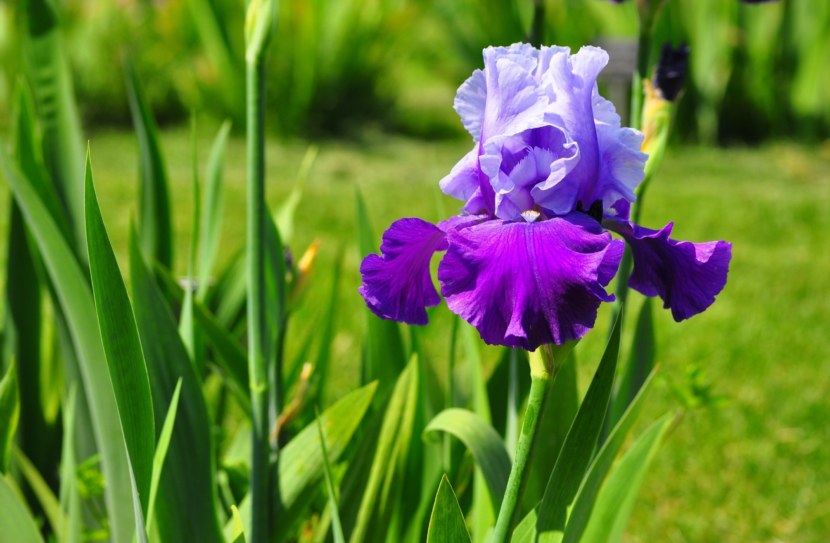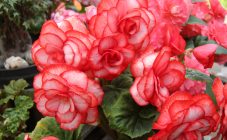Content:
The flora is rich and varied. Some crops love shade and moisture, while others grow only in sunny places and dry soils. And what do irises like? How easy is it to grow them in your garden? How to care for irises in the country? All this is discussed further.
The nuances of the care and cultivation of irises in the open field
This plant cannot be called whimsical. But for healthy growth and beautiful flowering, he still needs several conditions. In addition, it should be borne in mind that they are different in bearded, beardless and bulbous species.
Boarding time
In the spring, from March to May, as soon as the ground warms up, the planting material already acquired during the winter period is planted in the open ground, regardless of its type. That is, both rhizome and bulbous varieties. If properly planted, iris will bloom in early summer.
June - July is the best suited for breeding. Iris shoots are rooted in a greenhouse, but can also be grown outdoors by creating a small greenhouse above the sprout. However, the most successful way of dividing is still rhizome. The plant must have time to take root in order to endure the winter cold.
At the end of August, it is time to plant the iris bulbous species. They will delight with their flowering in early spring.
In the fall, a month before the onset of cold weather, all transplants in the open field should be completed. At the same time, you can sow iris seeds in pots for breeding at home.
Place for planting in open ground
Contrary to the misconception, iris for the most part does not like shady places and excess moisture. Grown with a lack of light, on moist soils, it loses its decorative effect and blooms for a short period. This does not apply to swamp varieties. But they also cannot stand water stagnation in the ground. When planting a plant in the garden, it is recommended to choose a place protected from strong winds. Otherwise, it will have to be additionally strengthened with supports.
Requirements for soil composition
The crop maintains abundant flowering and healthy growth in fertile, loamy soil with a neutral to slightly acidic reaction. Large doses of nitrogen in the ground cause various iris diseases. Sour soils will keep crops from blooming.
You can deoxidize the soil by adding chalk, ash, lime. It is recommended to introduce organic matter into soil with a high percentage of peat content before planting. In clay - sand or compost.
Watering
It is recommended to water the plant in the afternoon, under the root, without touching the leaves, twice a week. In the dry season - as the root zone dries up.
Top dressing requirements
It is recommended to feed the crop with different compositions of fertilizers:
- before flowering (during bud setting);
- after flowering is complete (to prepare for winter).
Additional requirements
Shelter - some varieties of rhizome irises need it for the winter. Digging - Bulbs after flowering (May, June) are recommended to be removed from the soil before planting in autumn.
How to care for irises outdoors in July and August
In these summer months, almost all iris varieties finish their flowering. Time to propagate, replant and begin preparing for the winter dormant period.
Reproduction
What to do with irises in July? By the middle of summer, the culture has a well-developed root system and sprouts appear on it. It is during this period that it is easier to propagate them by dividing the bush:
Transfer
What to do with irises in August? The last month of summer is favorable for transplanting.
Prepare the soil in advance. About a week before the event, it is necessary to dig up the ground to the depth of a shovel, apply fertilizer so as not to burn the plant roots.
Fertilization
When preparing a culture for winter, you need to take care of feeding. Phosphorus-potassium compounds are applied in July or August after the flowering of irises, according to the instructions on the packages. Phosphorus will strengthen the roots of the plant, and potassium will allow healthy buds of future peduncles to be laid.
Planting bulbous
In order for the planting material to adapt in the ground to cold weather, it is recommended to plant it already in the third decade of August or early September. The process takes very little time:
- in a small space, loosen the ground and make a depression;
- lightly press the bulbs into the ground and level it;
- mulch planting with compost;
- cover against the penetration of excess moisture with a non-hygroscopic material.
You can give a beautiful appearance to a flower bed of irises by forming it compactly, in small figures.
How to feed irises
In the spring, in order to help the plant quickly form green shoots, it is recommended to fertilize the soil with complex mixtures. A well-developed root system is essential for healthy growth. Phosphorus contributes to this process. And to grow beautiful and large green leaves, nitrogen is required, which comes from the soil through the roots. Nitrogen-phosphorus fertilizers are best applied at the very beginning of the growing season. It is allowed to feed the plant even in the snow at the end of March, the first days of April.
When it's time to bloom, potassium is needed. It is he who will help the plant bloom luxuriantly and for a long time. If one of the elements in the feeding is lacking, the cost of its implementation will not be crowned with success. Therefore, it is recommended to use two or three-component formulations. Watering with phosphate-potassium fertilizers will improve the quality and size of flowers.
How to feed irises after flowering in July? Having given strength to the formation of peduncles and the ground part, the plant is weakened. Therefore, it is susceptible to various diseases. Another source of potassium is wood ash. It can be sprinkled on the soil around the crop, reducing the acidity of the soil and preventing fungal infections.
Fertilizing irises with potash fertilizers with the addition of phosphorus is repeated 3-4 weeks after flowering, when buds of the next year begin to form and new roots grow.
For plants of the first year of life, the fertilizer rate indicated in the instructions is halved.
Transplant timing and sequence
To preserve the decorative variety, it is recommended to change the planting site every 3-5 years. You can replant the culture during the entire growing season. When to dig out irises for transplant? The best time is July or early August. If you plan to fertilize the soil, this should be done in advance.But in order not to burn the young roots, you can feed the flowers after rooting. Transplanting and subsequent care of irises requires consistency:
- the plant is removed from the ground;
- the peduncles are cut off, leaving a couple of centimeters from the root;
- the leaves are shortened to a height of 8–10 cm, giving the shape of a pitched roof;
- cut the roots by 1/3, remove dry ones;
- the rhizome is divided into parts, each of which has a growth point or a bunch of leaves;
- if rot was removed on the rhizome, then it is treated with a weak solution of manganese;
- sprinkle the cut sites with wood ash or crushed activated carbon and air dry for 2-3 days;
- make a deepening in the soil, add 200 g of sand, compost, ash and mix;
- an elevation is formed, the main root is placed on it, and the young roots-strings are straightened lower, in the direction of growth;
- sprinkle with earth, lightly tamp, leaving a recess for irrigation around the perimeter;
- if the planting is not single, observe the distance between the divisions from 30 to 70 cm, depending on the size of the roots.
Before the onset of cold weather, the culture will have time to take root and under cover it will successfully endure winter frosts. There is no need to extract it from the ground.
How to store irises before planting in the fall
When it comes time to dig up the irises, you need to think about storing them until future planting. Bulbous plant varieties are removed from the ground after flowering in 20 days. Do not wait for the leaves to turn yellow. The bulbs are dug up, cleaned from the ground. If necessary, rinse with a disinfectant. The roots are cut to 1–2 cm and dried in a warm ventilated room. Then, before planting, they are placed in a cool place.
Due to its exquisite and unusual shape, varied color palette, this plant has taken a strong position in landscape design. In addition, caring for irises in the garden and in personal plots does not require much effort. And the result of observing the basic rules of cultivation will be their abundant, lush and bright flowering.
